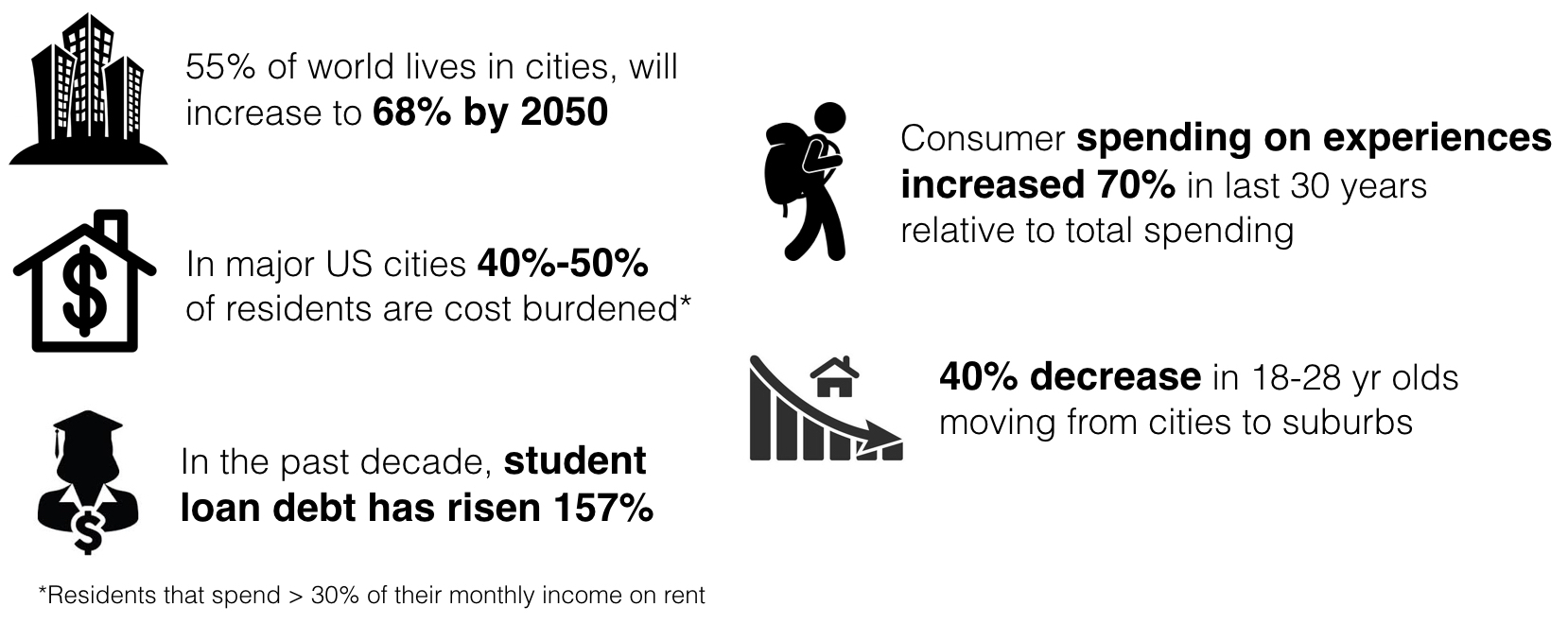After attending Common’s Coliving Capital Markets Summit, I am completely convinced: Coliving’s Time is Now.
The Opportunity
The opportunity for Coliving in the United States stems from a problem of which some of you reading this may still be unaware. The problem is a puzzle whose pieces are all major trends that you have certainly already heard about: urbanization, rising student loan debt, valuing experiences over things, and rent spikes in major US housing markets (NYC, SF, LA, etc.). Common‘s Coliving Capital Markets Summit told a story of why these trends are now coming together to form the perfect storm for a housing affordability crisis and why all arrows are pointing toward Coliving as the best solution.
What’s this housing affordability crisis you’re talking about and why is coliving the best solution? I’m glad you asked. One of the panelists at the Summit, Susan Tjarksen from Cushman & Wakefield, recently published an extensive research report (Survey of the Coliving Landscape) that contains many of the answers to the above questions. Let’s take a look at some of the staggering numbers found in the report:

Individually, each of these statistics is not troubling, but looked at together they paint quite a scary picture.
More people are living in cities and they’re living there for longer. Rents are rising, wages aren’t keeping pace, and student loan debt has financially burdened many potential homeowners. Due to this financial instability, millennials are not buying homes at the same rate as their parents and they seem just fine with it (they would rather go on an annual trip to Europe than own a bunch of furniture in a nice suburban home).
As seen in 2008 when the housing market stumbles, it doesn’t typically bode well for the American economy. So it begs the question: what can we do in reaction to these trends to help solve the housing affordability problem? How can we house more people in cities, at lower price points, and provide them with the experiences they’re looking for?
The answer is Coliving.
The Solution
Coliving can provide urban populations with an affordable place to live AND the community lifestyle they are searching for. Coliving locations typically trade bedroom square footage for more shared living space which allows them to house more residents than a typical apartment building of the same size.
Are residents willing to make this trade-off? During the conference we learned that Common received over 20,000 applications last month to fill the roughly 1,000 rooms they currently have on the market. Residents are certainly willing to make the trade-off and it appears the supply of Coliving units is nowhere close to keeping up with demand.

When compared to traditional urban apartments, Coliving stacks up quite favorably. After taking into account Coliving’s slightly higher development/building costs, higher operating expenses (for weekly events, fully furnished rooms), and additional gross revenue from rent (more beds, higher occupancy rates), Common estimates Coliving drives a 10%-30% increase in Net Operating Income.
The increase in net operating income creates a favorable investment for lenders as well as a stronger value proposition for real estate developers. The Coliving operator will benefit from the extra revenue generated and the tenants will pay a relatively lower rent price and benefit from the community lifestyle.
So who wins in Coliving? Well, everybody involved.

The Future
So now what? Due to this “win-for-all” approach, many of the nearly 300 people at Common’s Summit are extremely bullish on Coliving and expect an explosion in the number of Coliving developments in the upcoming years. In fact, Cushman & Wakefield’s survey reports that global investments in Coliving have skyrocketed from around $0.2 Billion in 2017 to $2.2 Billion in 2018.
Over the next few months I plan to visit many more Coliving spaces in the US and South East Asia in order to understand industry best practices and outline the different executions of coliving across the globe. Feel free to stop by Coliving Corner from time to time to follow my industry research and learn more about why Coliving’s Time is Now.

Hey Connor,
Great article!
I really like the co-living idea and I also believe it’s gonna be the “next thing”.
Can you please share more about the main differences between co-living and the traditional “shared houses” or hostels.
Thank you!!
LikeLike